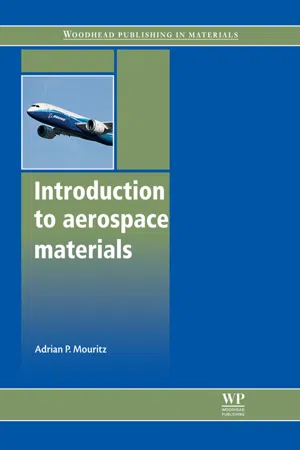
- 640 pages
- English
- ePUB (mobile friendly)
- Available on iOS & Android
Introduction to Aerospace Materials
About this book
The structural materials used in airframe and propulsion systems influence the cost, performance and safety of aircraft, and an understanding of the wide range of materials used and the issues surrounding them is essential for the student of aerospace engineering.Introduction to aerospace materials reviews the main structural and engine materials used in aircraft, helicopters and spacecraft in terms of their production, properties, performance and applications.The first three chapters of the book introduce the reader to the range of aerospace materials, focusing on recent developments and requirements. Following these introductory chapters, the book moves on to discuss the properties and production of metals for aerospace structures, including chapters covering strengthening of metal alloys, mechanical testing, and casting, processing and machining of aerospace metals. The next ten chapters look in depth at individual metals including aluminium, titanium, magnesium, steel and superalloys, as well as the properties and processing of polymers, composites and wood. Chapters on performance issues such as fracture, fatigue and corrosion precede a chapter focusing on inspection and structural health monitoring of aerospace materials. Disposal/recycling and materials selection are covered in the final two chapters.With its comprehensive coverage of the main issues surrounding structural aerospace materials, Introduction to aerospace materials is essential reading for undergraduate students studying aerospace and aeronautical engineering. It will also be a valuable resource for postgraduate students and practising aerospace engineers.- Reviews the main structural and engine materials used in aircraft, helicopters and space craft in terms of their properties, performance and applications- Introduces the reader to the range of aerospace materials, focusing on recent developments and requirements, and discusses the properties and production of metals for aerospace structures- Chapters look in depth at individual metals including aluminium, titanium, magnesium, steel and superalloys
Frequently asked questions
- Essential is ideal for learners and professionals who enjoy exploring a wide range of subjects. Access the Essential Library with 800,000+ trusted titles and best-sellers across business, personal growth, and the humanities. Includes unlimited reading time and Standard Read Aloud voice.
- Complete: Perfect for advanced learners and researchers needing full, unrestricted access. Unlock 1.4M+ books across hundreds of subjects, including academic and specialized titles. The Complete Plan also includes advanced features like Premium Read Aloud and Research Assistant.
Please note we cannot support devices running on iOS 13 and Android 7 or earlier. Learn more about using the app.
Information
Introduction to aerospace materials
1.1 The importance of aerospace materials
- • purchase cost of new aircraft;
- • cost of structural upgrades to existing aircraft;
- • design options for the airframe, structural components and engines;
- • fuel consumption of the aircraft (light-weighting);
- • operational performance of the aircraft (speed, range and payload);
- • power and fuel efficiency of the engines;
- • in-service maintenance (inspection and repair) of the airframe and engines;
- • safety, reliability and operational life of the airframe and engines; and
- • disposal and recycling of the aircraft at the end-of-life.
1.2 Understanding aerospace materials


Table of contents
- Cover image
- Title page
- Table of Contents
- Copyright
- Preface
- Chapter 1: Introduction to aerospace materials
- Chapter 2: Aerospace materials: past, present and future
- Chapter 3: Materials and material requirements for aerospace structures and engines
- Chapter 4: Strengthening of metal alloys
- Chapter 5: Mechanical and durability testing of aerospace materials
- Chapter 6: Production and casting of aerospace metals
- Chapter 7: Processing and machining of aerospace metals
- Chapter 8: Aluminium alloys for aircraft structures
- Chapter 9: Titanium alloys for aerospace structures and engines
- Chapter 10: Magnesium alloys for aerospace structures
- Chapter 11: Steels for aircraft structures
- Chapter 12: Superalloys for gas turbine engines
- Chapter 13: Polymers for aerospace structures
- Chapter 14: Manufacturing of fibre–polymer composite materials
- Chapter 15: Fibre–polymer composites for aerospace structures and engines
- Chapter 16: Metal matrix, fibre–metal and ceramic matrix composites for aerospace applications
- Chapter 17: Wood in small aircraft construction
- Chapter 18: Fracture processes of aerospace materials
- Chapter 19: Fracture toughness properties of aerospace materials
- Chapter 20: Fatigue of aerospace materials
- Chapter 21: Corrosion of aerospace metals
- Chapter 22: Creep of aerospace materials
- Chapter 23: Nondestructive inspection and structural health monitoring of aerospace materials
- Chapter 24: Disposal and recycling of aerospace materials
- Chapter 25: Materials selection for aerospace
- Index